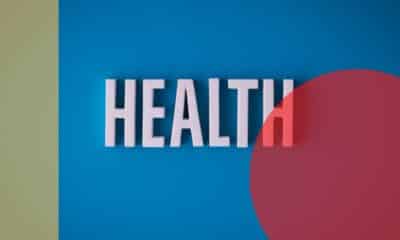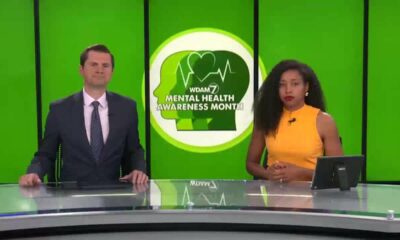Kaiser Health News
Cities Know the Way Police Respond to Mental Crisis Calls Needs to Change. But How?
Nicole Leonard, WHYY and Kate Wolffe, CapRadio and Simone Popperl
Thu, 08 Feb 2024 10:00:00 +0000
If you or someone you know may be experiencing a mental health crisis, contact the 988 Suicide & Crisis Lifeline by dialing “988,” or the Crisis Text Line by texting “HOME” to 741741.
Philadelphia police officers Kenneth Harper and Jennifer Torres were in their patrol car sitting at a red light when a call came in over the 911 radio dispatch.
“This job says ‘female complaint in reference to dispute with daughter, suffers from bipolar, infant on location,'” Harper read off the computer near the front seat.
The officers got a little more information from the dispatcher: A mother needed help with her adult daughter who had become combative after drinking alcohol.
It was a Friday morning. Harper and Torres quickly drove off in the direction of the address they were given just a few miles away. They traveled in a white SUV, absent of any police markings, with a third team member in the back seat, Krystian Gardner. Gardner is not a police officer. She's a mental health clinician and social worker.
“Do we know the age of the daughter?” Gardner asked the officers. She was preparing a list of possible services and treatment options.
As the team pulled up to a row house in North Philadelphia, the mother was waiting for them outside, on the front stoop. They spent 40 minutes with the family, working to de-escalate the immediate tension, provide the mom with support, and connect her daughter to treatment services.
The trio returned to the patrol car and got to work documenting what had happened and recording the visit in an electronic database.
Officer Torres commented on the adult daughter: “In regards to her mental health, she is taking care of herself, she's taking her medication, and she's going to therapy, so we don't need to help her too much on that aspect.”
“She's actually sleeping right now, so I gave her my card and she'll call us whenever she wakes up,” Torres added.
Soon, the radio crackled with their next call, to a home across town where an older woman with a history of mental disorders had wandered outside naked.
This visit took longer, over an hour, but had a similar outcome — help with the immediate mental health crisis, a connection to follow-up services with a case manager, and no arrest or use of force by police.
New Ways to Respond to Behavioral Health Needs
Emergency dispatchers in Philadelphia are increasingly assigning 911 calls involving people in mental health crises to the city's Crisis Intervention Response Team, which pairs police officers with civilian mental health professionals. This model is called a “co-responder program.”
Cities are experimenting with new ways to meet the rapidly increasing demand for behavioral health crisis intervention, at a time when incidents of police shooting and killing people in mental health crisis have become painfully familiar.
Big questions persist: What role should law enforcement play in mental crisis response, if any? How can leaders make sure the right kind of response is dispatched to meet the needs of a person in crisis? And what kind of ongoing support is necessary after a crisis response call?
City officials and behavioral health professionals often don't have easy answers, in part because the programs are new and hard data on their effectiveness is scarce. Without a single, definitive model for how to improve crisis response, cities are trying to learn from one another's successes and mistakes as they build and adjust their programs.
The Philadelphia Police Department established its Behavioral Health Unit in November 2022 and officially launched the co-responder crisis teams as a main feature.
The department said its goal is to meet people's immediate behavioral health needs, avoiding arrests or use of force, if possible. Philadelphia's program has answered about 600 calls since December 2022 — and only one case resulted in an arrest as of November 2023, according to city data.
In about 85% of cases, people experienced one of four major outcomes: They were connected to outpatient mental health and social services, voluntarily entered psychiatric treatment, were involuntarily committed to treatment, or were taken to a hospital for medical care.
“I think the practical experiences that people have had has really opened up a lot of people's eyes to what the work does, how it's actually reducing harm to the community,” said Kurt August, director of Philadelphia's Office of Criminal Justice.
Give a Social Worker a Dispatch Radio
City officials in Philadelphia looked to such cities as Los Angeles, Houston, and Denver, which have developed their own models over the years. They contacted people like Chris Richardson.
Richardson in 2016 helped found Denver's co-responder program, which pairs police officers with mental health professionals, like Philadelphia's CIRT program.
Denver residents had been unhappy with the status quo, Richardson recalled. At the time, rank-and-file police officers were the only ones responding to 911 calls involving people in crisis.
“We just heard a lot of those communities saying, ‘We wish there was something better,'” he said. “That's what kind of gave us that ability to start those conversations and start a partnership.”
Getting buy-in from law enforcement and other emergency response teams took time, Richardson said. Eventually, the co-responder program grew to include all police precincts and several fire departments.
Then, Denver city and county park rangers began requesting the aid of mental health professionals to accompany them while on patrol in public spaces, and during emergency calls.
“And then, somewhere in the middle there, we were like, you know, give a social worker a radio. We're like, why are we sending police to this, in general?” he said. “How do we take police out of things that don't need policing?”
Denver then launched a second model, its civilian response program, in 2019. It brings together paramedics and mental health professionals to respond to crisis calls — no police officers involved.
Now, Denver uses both models — the co-responder program with police, and the all-civilian response program — to cover Denver's crisis needs. Richardson said both programs are necessary, at least in Denver.
“It's a spectrum of care with behavioral health crises,” he said. “Some of it is really low-level. No threats, no safety concerns, no legal issues.”
But sometimes responders or community members may face serious safety concerns, and that's when a co-response team that includes police officers is needed, Richardson said.
“We want to make sure that that person in crisis is still getting taken care of,” he said.
Getting the Right Responders to the Right Call
Officials in Philadelphia want the police co-responder program to work in parallel with the city's existing network of civilian-only mental health response teams. The co-responder program is dispatched by 911, while the all-civilian program is activated when residents call 988.
The 988 system launched in July 2022, providing a three-digit number that can be dialed from any phone by people who are suicidal or experiencing a behavioral emergency. Calls are routed to a network of over 200 local and state-funded crisis centers.
“A large percentage of Philadelphians are not aware of 988,” said Jill Bowen, commissioner of the Philadelphia Department of Behavioral Health and Intellectual disAbility Services. “I like to say that people are born knowing to call 911, kind of come out of the womb and they know to call 911. And we really are trying to reach that kind of level of awareness.”
To help sort incoming calls, 911 dispatch centers in Philadelphia have been hiring mental health professionals. They can screen calls from people in crisis who don't need a police response, and forward them to 988.
Other cities and states are also struggling with confusion over how to handle the overlap between 911 and 988 calls.
Although 988 is a national network, calls are taken by regional call centers, which are overseen and managed by local governments. The federal Substance Abuse and Mental Health Services Administration said it is working on “building strong coordination between the two services,” but it's currently up to states and counties themselves to figure out how 911 and 988 work together.
National data collected one year after 988's implementation showed that most calls to the service can be handled with conversation and referrals to other services. But 2% of calls to 988 require rapid in-person intervention. In most states, the responding agency is 911, which deploys traditional law enforcement, or co-response teams, if they're available.
Next Steps: A Safe Place to Go
In states where awareness of 988 is higher, some behavioral health leaders are focused on a lack of continuing care resources for people in crisis.
During a July press conference marking one year since 988, Shari Sinwelski, the head of California's biggest crisis call center, described the ideal crisis response as a three-legged stool: “someone to talk to, someone to respond, a safe place to go.” The idea was introduced by SAMHSA in 2020.
In California, 44 out of its 58 counties have some form of mobile crisis response, meaning a team that can travel to someone in need, according to a 2021 survey conducted in partnership with the County Behavioral Health Directors Association of California.
However, the preparedness of these teams varies significantly. The survey identified that many of them don't operate 24/7, have long wait times (up to a day), and aren't equipped to handle children in crisis.
The same survey found that around 43% of the state's counties didn't have any physical place for people to go and stabilize during and after a crisis. WellSpace Health is California's second-biggest 988 center, by call volume, and is located in Sacramento County. A few years ago, WellSpace leaders decided it was time to open a crisis stabilization unit.
In summer 2020, WellSpace unveiled the Crisis Receiving for Behavioral Health center, known as “Crib,” in downtown Sacramento. The center receives people experiencing a mental health crisis or drug intoxication and allows them to stay for 24 hours and be connected to other services. The group says it has served more than 7,500 people since opening.
Physical locations linked to services, like Crib, are a crucial part of a well-functioning 988 system, said Jennifer Snow, national director of government relations and policy for the National Alliance on Mental Illness.
“Those crisis stabilization programs are really key to helping somebody not languish in the ER or unnecessarily get caught up in the criminal justice system,” she said.
Snow said it's too early to know how the nation is progressing overall on building up these kinds of centers.
“This is something I am dying to know, and we just don't,” she said.
Snow explained that the crisis care system has roots in law enforcement, so it tends to replicate law enforcement's decentralized and locally led structure.
“It makes it harder to look at it from a national perspective and, you know, be able to identify exactly where are these services and where are the gaps in services,” she said.
Building additional crisis centers, and hiring enough response teams to respond quickly, at all hours, in more areas of the U.S., would require significant investment. The current system relies heavily on state and local government funding, and more federal support is needed, Snow said.
In 2022, a group of legislators introduced the 988 Implementation Act in the House of Representatives. They were able to pass several provisions, including securing $385 million for certified community behavioral health clinics, which operate 24/7 crisis care, and $20 million for mobile crisis response pilot programs.
The bill was reintroduced in 2023, with the goal of passing the remaining sections. A significant provision would force Medicare and Medicaid, as well as private health insurance, to reimburse providers for crisis services.
This article is from a partnership that includes CapRadio, WHYY, NPR, and KFF Health News.
KFF Health News is a national newsroom that produces in-depth journalism about health issues and is one of the core operating programs at KFF—an independent source of health policy research, polling, and journalism. Learn more about KFF.
USE OUR CONTENT
This story can be republished for free (details).
——————————
By: Nicole Leonard, WHYY and Kate Wolffe, CapRadio and Simone Popperl
Title: Cities Know the Way Police Respond to Mental Crisis Calls Needs to Change. But How?
Sourced From: kffhealthnews.org/news/article/police-response-mental-crisis-calls-988/
Published Date: Thu, 08 Feb 2024 10:00:00 +0000
Kaiser Health News
Watch: John Oliver Dishes on KFF Health News’ Opioid Settlements Series
Fri, 17 May 2024 09:00:00 +0000
Opioid manufacturers, distributors, and retailers are paying tens of billions of dollars in restitution to settle lawsuits related to their role in the nation's overdose epidemic. A recent broadcast of “Last Week Tonight With John Oliver” examined how that money is being spent by state and local governments across the United States.
The segment featured reporting from the KFF Health News series “Payback: Tracking the Opioid Settlement Cash.” You can learn more about the issue and read our collection of articles by Aneri Pattani here.
——————————
Title: Watch: John Oliver Dishes on KFF Health News' Opioid Settlements Series
Sourced From: kffhealthnews.org/news/article/watch-john-oliver-kff-health-news-payback-opioid-settlements-series/
Published Date: Fri, 17 May 2024 09:00:00 +0000
Kaiser Health News
KFF Health News’ ‘What the Health?’: Bird Flu Lands as the Next Public Health Challenge
Thu, 16 May 2024 18:30:00 +0000
The Host
Julie Rovner
KFF Health News
Julie Rovner is chief Washington correspondent and host of KFF Health News' weekly health policy news podcast, “What the Health?” A noted expert on health policy issues, Julie is the author of the critically praised reference book “Health Care Politics and Policy A to Z,” now in its third edition.
Public health officials are watching with concern since a strain of bird flu spread to dairy cows in at least nine states, and to at least one dairy worker. But in the wake of covid-19, many farmers are loath to let in health authorities for testing.
Meanwhile, another large health company — the Catholic hospital chain Ascension — has been targeted by a cyberattack, leading to serious problems at some facilities.
This week's panelists are Julie Rovner of KFF Health News, Rachel Cohrs Zhang of Stat, Alice Miranda Ollstein of Politico, and Sandhya Raman of CQ Roll Call.
Panelists
Rachel Cohrs Zhang
Stat News
Alice Miranda Ollstein
Politico
Sandhya Raman
CQ Roll Call
Among the takeaways from this week's episode:
- Stumbles in the early response to bird flu bear an uncomfortable resemblance to the early days of covid, including the troubles protecting workers who could be exposed to the disease. Notably, the Department of Agriculture benefited from millions in covid relief funds designed to strengthen disease surveillance.
- Congress is working to extend coverage of telehealth care; the question is, how to pay for it? Lawmakers appear to have settled on a two-year agreement, though more on the extension — including how much it will cost — remains unknown.
- Speaking of telehealth, a new report shows about 20% of medication abortions are supervised via telehealth care. State-level restrictions are forcing those in need of abortion care to turn to options farther from home.
- And new reporting on Medicaid illuminates the number of people falling through the cracks of the government health system for low-income and disabled Americans — including how insurance companies benefit from individuals' confusion over whether they have Medicaid coverage at all.
Also this week, Rovner interviews Atul Grover of the Association of American Medical Colleges about its recent analysis showing that graduating medical students are avoiding training in states with abortion bans and major restrictions.
Plus, for “extra credit,” the panelists suggest health policy stories they read this week that they think you should read, too:
Julie Rovner: NPR's “Why Writing by Hand Beats Typing for Thinking and Learning,” by Jonathan Lambert.
Alice Miranda Ollstein: Time's “‘I Don't Have Faith in Doctors Anymore.' Women Say They Were Pressured Into Long-Term Birth Control,” by Alana Semuels.
Rachel Cohrs Zhang: Stat's “After Decades Fighting Big Tobacco, Cliff Douglas Now Leads a Foundation Funded by His Former Adversaries,” by Nicholas Florko.
Sandhya Raman: The Baltimore Banner's “People With Severe Mental Illness Are Stuck in Jail. Montgomery County Is the Epicenter of the Problem,” by Ben Conarck.
Also mentioned on this week's podcast:
- Stat's “My Rendezvous With the Raw Milk Black Market: Quick, Easy, and Unchecked by the FDA,” by Nicholas Florko.
- The Stamford Advocate's “Dan Haar: Hackers Stole a Disabled CT Couple's SNAP Food Aid. Now They're Out $1,373,” by Dan Haar.
- WKRN's “‘Chaos': Nurses, Visitors Describe Conditions Inside Ascension Hospitals After Cyberattack,” by Stephanie Langston.
- KFF Health News' “Medicaid ‘Unwinding' Decried as Biased Against Disabled People,” by Daniel Chang.
- KFF Health News' “Why Medicaid's ‘Undercount' Problem Counts,” by Phil Galewitz.
Credits
Francis Ying
Audio producer
Emmarie Huetteman
Editor
To hear all our podcasts, click here.
And subscribe to KFF Health News' “What the Health?” on Spotify, Apple Podcasts, Pocket Casts, or wherever you listen to podcasts.
——————————
Title: KFF Health News' ‘What the Health?': Bird Flu Lands as the Next Public Health Challenge
Sourced From: kffhealthnews.org/news/podcast/what-the-health-347-bird-flu-next-public-health-challenge-may-16-2024/
Published Date: Thu, 16 May 2024 18:30:00 +0000
Kaiser Health News
California’s $12 Billion Medicaid Makeover Banks on Nonprofits’ Buy-In
Angela Hart
Thu, 16 May 2024 09:00:00 +0000
TURLOCK, Calif. — For much of his young life, Jorge Sanchez regularly gasped for air, at times coughing so violently that he'd almost throw up. His mother whisked him to the emergency room late at night and slept with him to make sure he didn't stop breathing.
“He's had these problems since he was born, and I couldn't figure out what was triggering his asthma,” Fabiola Sandoval said of her son, Jorge, now 4. “It's so hard when your child is hurting. I was willing to try anything.”
In January, community health workers visited Sandoval's home in Turlock, a city in California's Central Valley where dust from fruit and nut orchards billows through the air. They scoured Sandoval's home for hazards and explained that harsh cleaning products, air fresheners, and airborne dust and pesticides can trigger an asthma attack.
The team also provided Sandoval with air purifiers, a special vacuum cleaner that can suck dust out of the air, hypoallergenic mattress covers, and a humidity sensor — goods that retail for hundreds of dollars. Within a few months, Jorge was breathing easier and was able to run and play outside.
The in-home consultation and supplies were paid for by Medi-Cal, California's Medicaid health insurance program for low-income residents. Gov. Gavin Newsom is spearheading an ambitious $12 billion experiment to transform Medi-Cal into both a health insurer and a social services provider, one that relies not only on doctors and nurses, but also community health workers and nonprofit groups that offer dozens of services, including delivering healthy meals and helping homeless people pay for housing.
These groups are redefining health care in California as they compete with businesses for a share of the money, and become a new arm of the sprawling Medi-Cal bureaucracy that serves nearly 15 million low-income residents on an annual budget of $158 billion.
But worker shortages, negotiations with health insurance companies, and learning to navigate complex billing and technology systems have hamstrung the community groups' ability to deliver the new services: Now into the third year of the ambitious five-year experiment, only a small fraction of eligible patients have received benefits.
“This is still so new, and everyone is just overwhelmed at this point, so it's slow-going,” said Kevin Hamilton, a senior director at the Central California Asthma Collaborative.
The collaborative has served about 3,650 patients, including Sandoval, in eight counties since early 2022, he said. It has years of experience with Medi-Cal patients in the Central Valley and has received about $1.5 million of the new initiative's money.
By contrast, CalOptima Health, Orange County's primary Medi-Cal insurer, is new to offering asthma benefits and has signed up 58 patients so far.
“Asthma services are so difficult to get going” because the nonprofit infrastructure for these services is virtually nonexistent, said Kelly Bruno-Nelson, CalOptima's executive director for Medi-Cal. “We need more community-based organizations on board because they're the ones who can serve a population that nobody wants to deal with.”
Newsom, a Democrat in his second term, says his signature health care initiative, known as CalAIM, seeks to reduce the cost of caring for the state's sickest and most vulnerable patients, including homeless Californians, foster children, former inmates, and people battling addiction disorders.
In addition to in-home asthma remediation, CalAIM offers 13 broad categories of social services, plus a benefit connecting eligible patients with one-on-one care managers to help them obtain anything they need to get healthier, from grocery shopping to finding a job.
The 25 managed-care insurance companies participating in Medi-Cal can choose which services they offer, and contract with community groups to provide them. Insurers have hammered out about 4,300 large and small contracts with nonprofits and businesses.
So far, about 103,000 Medi-Cal patients have received CalAIM services and roughly 160,000 have been assigned personal care managers, according to state data, a sliver of the hundreds of thousands of patients who likely qualify.
“We're all new to health care, and a lot of this is such a foreign concept,” said Helena Lopez, executive director of A Greater Hope, a nonprofit organization providing social services in Riverside and San Bernardino counties, such as handing out baseball cleats to children to help them be active.
Tiffany Sickler runs Koinonia Family Services, which offers California foster children mental health and other types of care, and even helped a patient pay off parking tickets. But the program is struggling on a shoestring budget.
“If you want to do this, you have to learn all these new systems. It's been a huge learning curve, and very time-consuming and frustrating, especially without adequate funding,” she said.
Brandon Richards, a Newsom spokesperson, defended CalAIM, saying that it was “on the cutting edge of health care” and that the state was working to increase “awareness of these new services and support.”
For nonprofits and businesses, CalAIM is a money-making opportunity — one that top state health officials hope to make permanent. Health insurers, which receive hefty payments from the state to serve more people and offer new services, share a portion with service providers.
In some places, community groups are competing with national corporations for the new funding, such as Mom's Meals, an Iowa-based company that delivers prepared meals across the United States.
Mom's Meals has an advantage over neighborhood nonprofit groups because it has long served seniors on Medicare and was able to immediately start offering the CalAIM benefit of home-delivered meals for patients with chronic diseases. But even Mom's Meals isn't reaching everyone who qualifies, because doctors and patients don't always know it's an option, said Catherine Macpherson, the company's chief nutrition officer.
“Utilization is not as high as it should be yet,” she said. “But we were well positioned, because we already had departments to do billing and contracting with health care.”
Middleman companies also have their eye on the billions of CalAIM dollars and are popping up to assist small organizations to go up against established ones like Mom's Meals. For instance, the New York-based Nonprofit Finance Fund is advising homeless service providers how to get more contracts and expand benefits.
Full Circle Health Network, with 70 member organizations, is helping smaller nonprofit groups develop and deliver services primarily for families and foster children. Full Circle has signed a deal with Kaiser Permanente, allowing the health care giant to access its network of community groups.
“We're allowing organizations to launch these benefits much faster than they've been able to do and to reach more vulnerable people,” said Camille Schraeder, chief executive of Full Circle. “Many of these are grassroots organizations that have the trust and expertise on the ground, but they're new to health care.”
One of the biggest challenges community groups face is hiring workers, who are key to finding eligible patients and persuading them to participate.
Kathryn Phillips, a workforce expert at the California Health Care Foundation, said there isn't enough seed money for community groups to hire workers and pay for new technology platforms. “They bring the trust that is needed, the cultural competency, the diversity of languages,” she said. “But there needs to be more funding and reimbursement to build this workforce.”
Health insurers say they are trying to increase the workforce. For instance, L.A. Care Health Plan, the largest Medi-Cal insurer in California, has given $66 million to community organizations for hiring and other CalAIM needs, said Sameer Amin, the group's chief medical officer.
“They don't have the staffing to do all this stuff, so we're helping with that all while teaching them how to build up their health care infrastructure,” he said. “Everyone wants a win, but this isn't going to be successful overnight.”
In the Central Valley, Jorge Sanchez is one of the lucky early beneficiaries of CalAIM.
His mother credits the trust she established with community health workers, who spent many hours over multiple visits to teach her how to control her son's asthma.
“I used to love cleaning with bleach” but learned it can trigger breathing problems, Sandoval said.
Since she implemented the health workers' recommendations, Sandoval has been able to let Jorge sleep alone at night for the first time in four years.
“Having this program and all the things available is amazing,” said Sandoval, as she pointed to the dirty dust cup in her new vacuum cleaner. “Now my son doesn't have as many asthma attacks and he can run around and be a normal kid.”
This article was produced by KFF Health News, which publishes California Healthline, an editorially independent service of the California Health Care Foundation.
——————————
By: Angela Hart
Title: California's $12 Billion Medicaid Makeover Banks on Nonprofits' Buy-In
Sourced From: kffhealthnews.org/news/article/newsom-medicaid-12-billion-dollar-makeover-nonprofits-bureacracy-calaim/
Published Date: Thu, 16 May 2024 09:00:00 +0000
-
SuperTalk FM4 days ago
Martin Lawrence making 3 stops in Mississippi on comedy tour
-
Our Mississippi Home3 days ago
Beat the Heat with Mississippi’s Best Waterparks
-
Mississippi Today7 days ago
Lawmakers may have to return to Capitol May 14 to override Gov. Tate Reeves’ potential vetoes
-
Our Mississippi Home4 days ago
Charlie’s U-Pik: Opening Soon for the Summer Season
-
Mississippi News Video6 days ago
Local dentists offer free dental care in Amory
-
Kaiser Health News3 days ago
Medicaid ‘Unwinding’ Decried as Biased Against Disabled People
-
Mississippi News Video2 days ago
Jackson has a gang problem
-
Mississippi News7 days ago
Bond set for West Point couple accused of killing their child




























![HIGH SCHOOL SOFTBALL: Vancleave @ East Central (5/9/2024) [5A Playoffs, South State]](https://www.biloxinewsevents.com/wp-content/uploads/2024/05/1715460379_maxresdefault-80x80.jpg)







